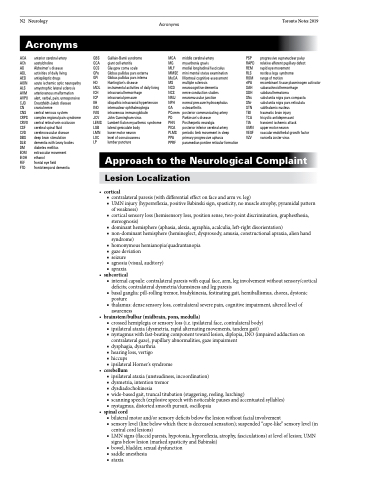Page 744 - TNFlipTest
P. 744
N2 Neurology
Acronyms
Toronto Notes 2019
Acronyms
ACA anterior cerebral artery
ACh acetylcholine
AD Alzheimer’s disease
ADL activities of daily living
AED antiepileptic drugs
AION acute ischemic optic neuropathy ALS amyotrophic lateral sclerosis AVM arteriovenous malformation AVPU alert, verbal, pain, unresponsive CJD Creutzfeldt-Jakob disease
GBS Guillain-Barré syndrome MCA GCA giant cell arteritis MG GCS Glasgow coma scale MLF GPe Globus pallidus pars externa MMSE GPi Globus pallidus pars interna MoCA HD Huntington’s disease MS IADL instrumental activities of daily living NCD ICH intracranial hemorrhage NCS ICP intracranial pressure NMJ IIH idiopathic intracranial hypertension NPH INO internuclear ophthalmoplegia OA IVIG intravenous immunoglobulin PComm JCV John Cunningham virus PD LEMS Lambert-Eaton myasthenic syndrome PHN LGB lateral geniculate body PICA LMN lower motor neuron PLMS
level of consciousness PPA lumbar puncture PPRF
middle cerebral artery
myasthenia gravis
medial longitudinal fasciculus
mini mental status examination Montreal cognitive assessment multiple sclerosis
neurocognitive dementia
nerve conduction studies neuromuscular junction
normal pressure hydrocephalus osteoarthritis
posterior communicating artery Parkinson’s disease
Postherpetic neuralgia
posterior inferior cerebral artery periodic limb movement in sleep primary progressive aphasia paramedian pontine reticular formation
PSP progressive supranuclear palsy RAPD relative afferent pupillary defect REM rapid eye movement
RLS restless legs syndrome
ROM range of motion
rtPA recombinant tissue plasminogen activator SAH subarachnoid hemorrhage
SDH subdural hematoma
SNc substantia nigra pars compacta
SNr substantia nigra pars reticulata
STN subthalamic nucleus
TBI traumatic brain injury
TCA tricyclic antidepressant
TIA transient ischemic attack
UMN upper motor neuron
VEGF vascular endothelial growth factor
VZV varicella zoster virus
CN cranial nerve
CNS central nervous system
CRPS complex regional pain syndrome
CRVO central retinal vein occlusion
CSF cerebral spinal fluid
CVD cerebrovascular disease
DBS deep brain stimulation LOC DLB dementia with Lewy bodies LP DM diabetes mellitus
EOM extraocular movement
EtOH ethanol
FEF frontal eye field
FTD frontotemporal dementia
Approach to the Neurological Complaint
Lesion Localization
• cortical
■ contralateral paresis (with differential effect on face and arm vs. leg)
■ UMN injury (hyperreflexia, positive Babinski sign, spasticity, no muscle atrophy, pyramidal pattern
of weakness)
■ cortical sensory loss (hemisensory loss, position sense, two-point discrimination, graphesthesia,
stereognosis)
■ dominant hemisphere (aphasia, alexia, agraphia, acalculia, left-right disorientation)
■ non-dominant hemisphere (hemineglect, dysprosody, amusia, constructional apraxia, alien hand
syndrome)
■ homonymous hemianopia/quadrantanopia
■ gaze deviation
■ seizure
■ agnosia (visual, auditory) ■ apraxia
• subcortical
■ internal capsule: contralateral paresis with equal face, arm, leg involvement without sensory/cortical deficits; contralateral dysmetria/clumsiness and leg paresis
■ basal ganglia: pill-rolling tremor, bradykinesia, festinating gait, hemiballismus, chorea, dystonic posture
■ thalamus: dense sensory loss, contralateral severe pain, cognitive impairment, altered level of awareness
• brainstem/bulbar(midbrain,pons,medulla)
■ crossed hemiplegia or sensory loss (i.e. ipsilateral face, contralateral body)
■ ipsilateral ataxia (dysmetria, rapid alternating movements, tandem gait)
■ nystagmus with fast-beating component toward lesion, diplopia, INO (impaired adduction on
contralateral gaze), pupillary abnormalities, gaze impairment ■ dysphagia, dysarthria
■ hearing loss, vertigo
■ hiccups
■ ipsilateral Horner's syndrome
• cerebellum
■ ipsilateral ataxia (unsteadiness, incoordination)
■ dysmetria, intention tremor
■ dysdiadochokinesia
■ wide-based gait, truncal titubation (staggering, reeling, lurching)
■ scanning speech (explosive speech with noticeable pauses and accentuated syllables) ■ nystagmus, distorted smooth pursuit, oscillopsia
• spinalcord
■ bilateral motor and/or sensory deficits below the lesion without facial involvement
■ sensory level (line below which there is decreased sensation); suspended “cape-like” sensory level (in
central cord lesions)
■ LMN signs (flaccid paresis, hypotonia, hyporeflexia, atrophy, fasciculations) at level of lesion; UMN
signs below lesion (marked spasticity and Babinski)
■ bowel, bladder, sexual dysfunction
■ saddle anesthesia
■ ataxia


